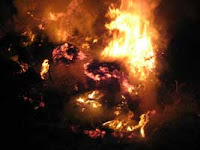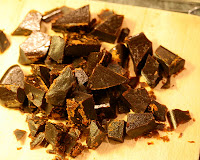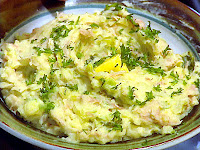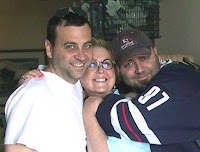
I like to think I look at things from a different perspective than most, at least when it comes to food. It is, I hope, one of the reasons you read me. I'm a
why guy and with that question, usually comes good information. Usually. I have found that when I know the why of something, or someone, I understand that person or thing a bit better. Sometimes for good...sometimes for bad. But hey, life's a crap shoot right? You don't gain if you don't risk. What does this have to do with Halloween? Actually, not much, but thanks for listening.
Except maybe to say that I'm going to take a completely different look at Halloween. Culturally, through food. What a surprise. See when I was an Italian kid, in North Jersey, we would go
trick or treating in the neighborhoods we grew up in. Neighborhoods with the same neighbors, usually aunts, or cousins or cousin of a cousin. In the same houses, for years upon end. People we trusted and in some cases loved. At Halloween, that meant we used to get home baked pies, fresh from the oven cookies, and treats made by the people from scratch. Real food items from neighbors, friends and family. I always thought that was cool. Even then I was a foodie in training.
Don't get me wrong, I loved all the candy as well, eating it until I was tooth-achingly nauseous. But, the home-made 'treats' we received usually meant sitting down at the table with a glass of milk and questions about your mom and dad and family. You then wiped your face on the back of your hand, kissed Aunt Josephine and raced off to the Aunt Rosina's for the next visit and course. By the time you got home, you were stuffed! I loved stopping by 10 relatives houses, 'making the rounds,' seeing my aunts, uncles, cousins, family and friends on our little three hour tour. It got me thinking about all those treats and I decided to take look at some of the food traditions of Halloween.
Admittedly there are many beliefs, misconceptions and traditions which surround this holiday. I say h
oliday with an asterisk, like they use in the Baseball Hall of Fame, in Cooperstown, when there is a disputed record. Halloween is that kind of day. It's Pagen, it's Christian, It's evil, it's innocent. It's harmless, it's Mischief Night...it's...well whatever!
Trick or Treat! BOO!
Halloween
Halloween or
Hallowe'en as we refer to it now, is also known as All Hallows' Eve, observed around the world on October 31 on the eve of the Western Christian feast of All Hallows. Most scholars believe that All Hallows' Eve was originally influenced by western European harvest festivals and festivals of the dead, with pagan roots, particularly the Celtic Samhain. Many ancient and unconnected cultures (the Egyptians and pre-Spanish Mexicans,
for example) celebrated this as a festival of the dead. Others maintain that it originated independently of Samhain. I was actually amazed when I started to do the research, that what I thought was a very American holiday, is in fact an ancient ritual dating back centuries. Now we have definitely made it a national pastime here in America, but I was more interested in a look at the traditions around the world.

The majority of
our modern traditions can be traced to the British Isles. People took steps to allay or ward-off these harmful spirits/fairies, which is thought to have influenced today's Halloween customs. In parts of Ireland, Mann, the Scottish Highlands and Islands, and Wales, wearing costumes at Samhain was done before the 20th century originating as a means of disguising oneself from these harmful spirits/fairies. In Ireland, people went about before nightfall collecting for Samhain feasts and sometimes wore costumes while doing so.

In the 19th century on Ireland's southern coast, a man dressed as a white mare would lead youths door-to-door collecting food; by giving them food, the household could expect good fortune from the 'Muck Olla'. In Moray, during the 18th century, boys called at each house in their village asking for fuel for the Samhain bonfire. So it's easy to see where Trick-or-treating may have come from. But wait, it also may come from the Christian custom of souling; Groups of poor people, often children, would go door-to-door on All Saints/All Souls collecting soul cakes, originally as a means of praying for souls in purgatory. Making jack-o'-lanterns at Halloween came from Samhain and Celtic beliefs as well. Turnip lanterns, sometimes with faces carved into them are recorded in Ireland and the Scottish Highlands. One custom that persists in modern-day Ireland is the baking of a barmbrack (Irish: báirín breac),
which is a light fruitcake, into which a plain ring, a coin and other
charms are placed before baking. It is said that those who get a ring
will find their true love in the ensuing year. Though the origin of the word Halloween is Christian, the holiday is commonly thought to have pagan roots.
North American almanacs of the late 18th and early 19th century give no indication that Halloween was recognized as a holiday there. The traditions and importance of the Halloween celebration vary significantly among countries that observe it. In Scotland and Ireland, traditional Halloween customs include children dressing up in costume going "guising", holding parties, while other practices in Ireland include lighting bonfires, and having firework displays. The influence of the American iconic and commercial components of the holiday now extended to places such as South America, Australia, New Zealand, (most) continental Europe, Japan, and other parts of East Asia.
Halloween Food around the World
Barmbrack (Ireland)
Barmbrack is the center of an Irish Halloween custom. The Halloween Brack traditionally contained various objects baked into the bread and was used as a sort of fortune-telling game. In the barmbrack were: a pea, a stick, a piece of cloth, a small coin (originally a silver sixpence) and a ring. Each item, when received in the slice, was supposed to carry a meaning to the person concerned: the pea, the person would not marry that year; the stick, would have an unhappy marriage or continually be in disputes; the cloth or rag, would have bad luck or be poor; the coin, would enjoy good fortune or be rich; and the ring, would be wed within the year. Other articles added to the brack include a medallion, usually of the Virgin Mary to symbolise going into the priesthood or to the Nuns, although this tradition is not widely continued in the present day
Bonfire toffee (Great Britain)
Bonfire toffee (also known as treacle toffee, cinder toffee, Plot toffee, or Tom Trot) is a hard, brittle toffee associated with Halloween and Guy Fawkes Night (also known as "Bonfire Night") in the United Kingdom. The toffee tastes very strongly of molasses (black treacle), and cheap versions can be quite bitter. In Scotland, the treat is known as claggum, with less sweet versions known as clack. In Wales, it is known as
loshin du. The flavor is similar to that of butterscotch, although it is a toffee and never a viscous liquid.
Candy apples/toffee apples (Great Britain & Ireland)

Candy apples, also known as toffee apples outside of North America, are whole apples covered in a hard toffee or sugar candy coating, with a stick inserted as a handle. These are a common treat at autumn festivals in Western culture in the Northern Hemisphere, such as Halloween and Guy Fawkes Night because these festivals fall in the wake of the annual apple harvest. Although candy apples and caramel apples may seem similar, they are made using distinctly different processes.

William W. Kolb invented the red candy apple. Kolb, a veteran Newark candy-maker, produced his first batch of candied apples in 1908. While experimenting in his candy shop with red cinnamon candy for the Christmas trade, he dipped some apples into the mixture and put them in the windows for display. He sold the whole first batch for 5 cents each and later sold thousands yearly. Soon candied apples were being sold along the Jersey Shore, at the circus and in candy shops across the country, according to the Newark News in 1948.
Caramel Apples

Caramel apples or taffy apples (not to be confused with candy apples) are created by dipping or rolling apples-on-a-stick in hot caramel, sometimes then rolling them in nuts or other small savories or confections, and allowing them to cool. Generally, they are called caramel apples when only caramel is applied and taffy apples for when there are further ingredients such as peanuts applied.
Caramel Corn

An American confection made of popcorn coated with a sugar or molasses based caramel candy shell. Typically a sugar solution or syrup is made and heated until it browns and becomes thick, producing a caramelized candy syrup. This hot candy is then mixed with popped popcorn, and allowed to cool. Sometimes a candy thermometer is used, as making caramel is time-consuming and requires skill to make well without burning the sugar. The process creates a sweet flavored, crunchy snack food or treat. Some varieties, after coating with the candy syrup, are baked in an oven to crisp the mixture. Mixes of caramel corn sometimes contain nuts, such as peanuts, pecans, almonds, or cashews. The combination of caramel and corn dates back at least as far as the 1890s with the strong molasses flavor of Cracker Jack, an early version of which was introduced at the Chicago World's Fair in 1893. The lighter, sweet but un-caramelized kettle corn, may be a North American Colonial predecessor to caramel corn.
Candy Corn, (North America)
Candy corn is a confection in the United States and Canada, popular primarily in autumn around Halloween (though available year-round in most places). Candy corn was created in the 1880s by George Renninger of the Wunderlee Candy Company; the three colors of the candy mimic the appearance of kernels of corn. Each piece is approximately three times the size of a whole kernel from a ripe or dried ear. Candy corn is made primarily from sugar, corn syrup, wax, artificial coloring and binders.
A serving of Brach's Candy Corn is nineteen pieces, is 140 calories and has zero grams of fat.
Candy corn pieces are traditionally cast in three colors: a broad yellow end, a tapered orange center, and a pointed white tip.
Colcannon (Ireland)
Colcannon is traditionally made from mashed potatoes and kale (or cabbage), with scallions, butter, salt and pepper added. It can contain other ingredients such as milk, cream, leeks, onions and chives. There are many regional variations of this dish. It is often eaten with boiled ham or Irish bacon. At one time it was a cheap, year-round staple food, though nowadays it is usually eaten in autumn/winter, when kale comes into season. An old Irish Halloween tradition is to serve colcannon with a ring and a thimble hidden in the fluffy green-flecked dish. Prizes of small coins such as threepenny or sixpenny bits were also concealed in it.
Soul Cakes
A soul cake is a small round cake which is traditionally made for All Saints Day or All Souls' Day to celebrate the dead. The cakes, often simply referred to as souls, were given out to soulers (mainly consisting of children and the poor) who would go from door to door on Halloween singing and saying prayers for the dead. Each cake eaten would represent a soul being freed from Purgatory. The practice of giving and eating soul cakes is often seen as the origin of modern trick-or-treating. In Lancashire and in the North-east of England they were also known as Harcakes.
The tradition of giving soul cakes was celebrated in Britain or Ireland during the Middle Ages, although similar practices for the souls of the dead were found as far south as Italy. The cakes were usually filled with allspice, nutmeg, cinnamon, ginger or other sweet spices, raisins or currants, and before baking were topped with the mark of a cross to signify that these were alms. They were traditionally set out with glasses of wine on All Hallows Eve as an offering for the dead, and on All Saints Day and All Soul's Day children would go "souling," or ritually begging for cakes door to door.
Soul Cakes
T. Susan Chang for NPR
Makes 12 to 15 2-inch soul cakes
Ingredients
2 cups all-purpose flour
1/2 teaspoon nutmeg, ground fresh if possible
1/2 teaspoon cinnamon, ground fresh if possible
1/2 teaspoon salt
generous pinch of saffron
1/2 cup milk
1 stick (8 tablespoons) unsalted butter, softened
1/2 cup sugar
2 egg yolks
1/2 cup currants
For the Glaze:
1 egg yolk, beaten
Method
Preheat oven to 400 degree. Combine the flour, the nutmeg, cinnamon and salt in a small bowl. Mix well with a fork. Crumble the saffron threads into a small saucepan and heat over low heat just until they become aromatic, taking care not to burn them. Add the milk and heat just until hot to the touch. The milk will have turned a bright yellow. Remove from heat. Cream the butter and sugar together in a medium bowl with a wooden spoon (or use an electric mixer with the paddle attachment). Add the egg yolks and blend in thoroughly with the back of the spoon. Add the spiced flour and combine as thoroughly as possible; the mixture will be dry and crumbly.
One tablespoon at a time, begin adding in the warm saffron milk, blending vigorously with the spoon. When you have a soft dough, stop adding milk; you probably won't need the entire half-cup.
Turn the dough out onto a floured counter and knead gently, with floured hands, until the dough is uniform. Roll out gently to a thickness of 1/2 inch. Using a floured 2-inch round cookie or biscuit cutter, cut out as many rounds as you can and set on an ungreased baking sheet. You can gather and re-roll the scraps, gently. Decorate the soul cakes with currants and then brush liberally with the beaten egg yolk. Bake for 15 minutes, until just golden and shiny.
Bon Appetit,
Lou
Sources: foodnetwork.com, http://www.freedigitalphotos.net/
 As we enter this Holiday Season, you can be the difference! You can be the change! You can help hungry children get the proper nutrition they deserve by getting involved with events or causes that can help feed our kids.
As we enter this Holiday Season, you can be the difference! You can be the change! You can help hungry children get the proper nutrition they deserve by getting involved with events or causes that can help feed our kids. Next, get baking or attend a Bake Sale for No Kid Hungry, presented by my friends at Domino® Sugar and C&H® Sugar. This is a national fundraising initiative that encourages people like you to host bake sales in your communities or attend one to help end childhood hunger.
Next, get baking or attend a Bake Sale for No Kid Hungry, presented by my friends at Domino® Sugar and C&H® Sugar. This is a national fundraising initiative that encourages people like you to host bake sales in your communities or attend one to help end childhood hunger.




























